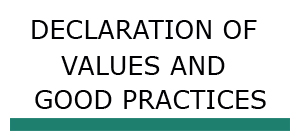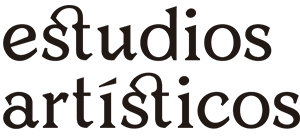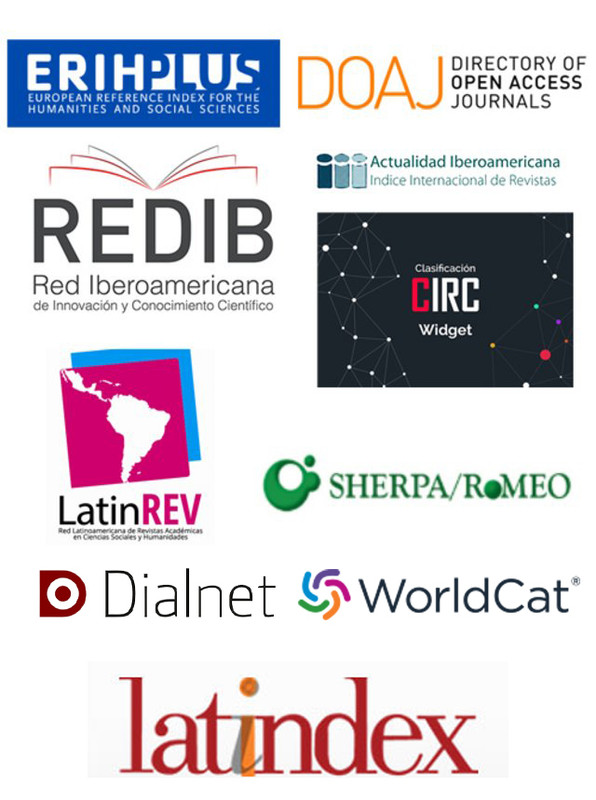Diretrizes para Autores
Guía para autores
- Del carácter de la revista y sus objetivos
Estudios Artísticos: Revista de investigación creadora es un medio de circulación de saberes y conocimientos producidos por las comunidades inter-epistémicas del campo emergente de los Estudios Artísticos. Como medio de comunicación facilita la construcción de comunidades artísticas, disciplinares, interdisciplinares y transdisciplinares, as. como redes de investigadores en el ámbito nacional e internacional. Ante todo, propende por la apropiación social de las diversas formas del conocimiento como medio para transformación de sujetos y colectividades.
Desde su primera publicación en el año 2015, Estudios Artísticos realiza su proceso de revisión y publicación de artículos sin costo alguno para el autor. Cualquier autor, sin importar su nacionalidad, puede enviar sus artículos (véase la tipología de artículos en la parte inferior) a través del sistema OJS para iniciar el proceso de evaluación. Cuando este proceso de evaluación culmine y en caso de ser aprobado (descripción de la evaluación en la parte inferior) el artículo será publicado.
Público Objetivo
Estudios Artísticos está dirigida a docentes, investigadores, estudiantes y profesionales interesados en la actualización permanente de sus conocimientos y el seguimiento de los procesos de investigación-creación en el campo del arte y los estudios artísticos.
Misión
Divulgar resultados de proyectos de investigación-creación realizados en el campo del arte y los estudios artísticos, a través de la publicación de artículos originales e inéditos, realizados por académicos artistas y profesionales pertenecientes a instituciones nacionales o extranjeras del sector público o privado.
Alcance geográfico
Estudios Artísticos tiene alcance en Ameríca Latina, España y el Caribe. Sin embargo, su circulación tiene potencia global.
Institución Editora
Estudios Artísticos es editada por la Universidad Distrital Francisco José de Caldas, Centro de Investigaciones y Desarrollo Científico CIDC y Facultad de Artes ASAB. La revista tiene su oficina en la Unidad de Investigaciones de la Facultad de Artes ASAB, Cra.13 No. 14-69, Bogotá. D.C. Teléfono: 3239300 ext.: 6624; email: revestudiosartisticos.ud@udistrital.edu.co
- Del carácter pluriligue de la revista
Estudios Artísticos publica artículos inéditos en varios idiomas, que sean resultado de la actividad investigadora, académica y creadora de las comunidades del campo del arte en el contexto nacional e internacional.
III. Periodicidad
Estudios Artísticos tiene una periodicidad semestral.
- De lasseccionesque constituyen la revista
- Editorial: escrito por el editor, por un invitado, por uno o varios miembros del Comité Editorial/Científico.
- Sección Central: está constituida por los artículos de investigación, reflexión y revisión que sean aprobados para cada número, incluyendo el artículo del autor invitado.
- Expresiones emergentes: es un espacio para jóvenes investigadores y creadores.
- Pensamiento sensible: propuestas relevantes de artistas y creadores que sean consistentes con el enfoque de la revista.
- Otras textualidades: en esta sección se presentan, de manera no permanente, artículos del siguiente tipo: artículo corto, reporte de caso, revisión de tema, cartas al editor, traducción, documento de reflexión no derivado de investigación, reseña bibliográfica y otros.
- De la convocatoria pública para presentar artículos
Estudios Artísticos tiene una convocatoria abierta y permanente; realiza dos recortes durante el año para seleccionar los artículos aprobados para cada número. La temática de los artículos es abierta a los problemas relevantes del campo del arte.
- De los tipos de documentos aceptados
Los artículos seleccionados deben estar articulados a investigaciones en curso o terminadas. En consecuencia, deben exhibir coherencia conceptual, profundidad en el tratamiento de un problema y estar escritos en un estilo claro, ágil y estructurado según la naturaleza del texto. Se aceptan únicamente artículos inéditos.
Podrán presentarse los siguientes tipos de artículos:
- Artículo de investigación artística, científica y tecnológica:presenta, de manera detallada, los resultados originales de proyectos de investigación. La estructura generalmente utilizada contiene cuatro apartes importantes: introducción, metodología, resultados y conclusiones.
- Artículo de reflexión:presenta resultados de investigación desde una perspectiva analítica, interpretativa o crítica del autor, sobre un tema específico, recurriendo a fuentes originales
- Artículo de revisión:documento resultado de una investigación donde se analizan, sistematizan e integran los resultados de las investigaciones publicadas o no publicadas, sobre un campo en arte ciencia o tecnología, con el fin de dar cuenta de los avances y las tendencias de desarrollo. Se caracteriza por presentar una cuidadosa revisión bibliográfica de por lo menos 50 referencias.
- Artículo corto:documento breve que presenta resultados originales preliminares o parciales de una investigación artística, científica o tecnológica, que por lo general requieren de una pronta difusión.
- Reporte de caso:documento que presenta los resultados de un estudio sobre una situación particular con el fin de dar a conocer las experiencias técnicas y metodológicas consideradas en un caso específico. Incluye una revisión sistemática comentada de la literatura sobre casos análogos.
- Revisión de tema: documento resultado de la revisión crítica de la literatura sobre un tema en particular.
- Cartas al editor: posiciones críticas, analíticas o interpretativas sobre los documentos publicados en la revista, que a juicio del Comité editorial constituyen un aporte importante a la discusión del tema por parte de la comunidad científica de referencia.
- documento escrito por el editor, un miembro del comité editorial o un investigador invitado sobre orientaciones en el dominio temático de la revista.
- Traducción. traducciones de textos clásicos o de actualidad o transcripciones de documentos históricos o de interés particular en el dominio de publicación de la revista.
- Documento de reflexión no derivado de investigación.
- Reseña bibliográfica: se trata de un trabajo objetivo sin comentarios ni opiniones personales acerca del texto reseñado.
- Otros: que sean pertinentes para alguna de las secciones de la revista diferentes a la sección central.
VII. De la forma de presentación de los manuscritos
Tenga en cuenta que los manuscritos que no se ajusten a estas características serán devueltos y el autor tendrá un plazo de quince días para presentarlo de nuevo. El manuscrito debe presentarse en un archivo compatible con Word, en hoja de tamaño carta (21,59 cm x 27,54 cm), con márgenes de carácter moderado, en letra Times New Roman de tamaño 12, a espacio sencillo, sin separación entre párrafos y alineado a la izquierda.
Los artículos no deben superar 7.000 palabras de extensión, incluyendo título, subtítulo, resúmenes, palabras clave, notas al pie, lista de referencias y anexos.
Además del contenido central, únicamente deben aparecer:
- Título, que resuma en forma clara la idea principal de la investigación
- Tipo de artículo (investigación, reflexión, revisión, etc., de acuerdo al listado de artículos aceptados)
- Nombres del ( los) autor(es) del trabajo, normalizados de acuerdo con su forma de citación.
- Vinculación institucional, dirección postal, teléfonos y correos electrónicos (para todos los autores).
- Vinculación institucional del (los) autor(es); dirección postal, teléfonos y correos electrónicos (para todos los autores).
- Agradecimientos e información sobre la naturaleza del manuscrito.
- Resumen: resumen breve pero abarcador sobre el contenido de la monografía. El resumen no debe exceder las 150 palabras. Se sugiere incluir: la pregunta o problema central, el marco o perspectiva teórica, metodología, los principales hallazgos, conclusiones y direcciones futuras de investigación.
- Palabras claves, un mínimo de tres y máximo seis, ordenadas alfabéticamente.
- Resumen en inglés (abstract).
- Palabras claves en inglés.
- Referencias numeradas a gráficas, tablas, cuadros o imágenes.
- Títulos y pies de gráficas, tablas, cuadros o imágenes.
- Lista completa de referencias.
- Presentación de material adicional
Los gráficos y las tablas se insertan en el texto, debidamente numerados según su orden de presentación. Cada uno debe tener un título breve que indique claramente su contenido. La revista exige el envío, por separado, de los archivos originales de cuadros, gráficos o diagramas en Excel, Word, PowerPoint o cualquier otro programa; las fotografías de obras de arte deben contener la ficha técnica y los créditos del fotógrafo y de la fuente correspondiente. En el caso de fotografías, planos, dibujos, imágenes o capturas de pantalla, favor hacerlos llegar en formato vectorial (TIF, CDR, EPS, SVG u otros) con una resolución mínima de 300 dpi (puntos por pulgada). Todas las tablas, gráficas, cuadros o imágenes que se incluyan en los artículos deben ser autoexplicativos, claros y pertinentes. En caso de que no sean trabajo original del autor, es su responsabilidad obtener los permisos que se requieran para su publicación.
- Referencias
Al final del trabajo se incluirá un listado ordenado alfabéticamente siguiendo normas internacionales de la American Psychological Association (APA) en la más reciente edición. (Para mayor información véase el manual de estilo de Estudios Artísticos).
VIII. Sobre el envío de los artículos
Sin excepción, los artículos deben enviarse a trávés de la plataforma OJS de la revista Estudios Artísticos: (http://revistas.udistrital.edu.co/ojs/index.php/estart) realizando el correpondiente registro del autor. De esta manera, será posible para los autores hacer el seguimiento al proceso de evaluación y edición de sus artículos. No se considerarán artículos incompletos o que no cumplan con las normas aquí establecidas
IX. DE LOS CRITERIOS Y PROCEDIMIENTOS DE EVALUACIÓN DE LOS ARTÍCULOS
Todos los artículos serán sometidos a un proceso de arbitraje anónimo, llevado a cabo por evaluadores nacionales o extranjeros que podrán hacer sugerencias al autor. El autor debe tener en cuenta las observaciones de los revisores, del Editor o del Comité Editorial de la revista para realizar los ajustes necesarios. El Comité Editorial decide a propuesta del editor la publicación de los artículos aprobados en el número correspondiente.
Estudios Artísticos se reserva el derecho de introducir los cambios formales necesarios para adaptar el texto a los estándares de publicación.
X. SOBRE LOS DERECHOS DE PUBLICACIÓN DE LOS AUTORES
El autor conserva sus derechos morales, intelectuales, de privacidad y publicidad. Estudios Artísticos no retiene los derechos sobre las obras publicadas y los contenidos son responsabilidad exclusiva de los autores. La revista garantiza el reconocimiento de los créditos por su trabajo y autoría.
Estudios Artísticos no altera, ni transforma o genera una obra a partir del artículo. Adicional a ello se garantiza al autor que no se utilizará su artículo para fines comerciales.
XI. DE LA POLÍTICA DE ACCESO DE LA PUBLICACIÓN
Estudios Artísticos es una publicación académica, inspirada en las ideas de acceso abierto y por la autorización expresa de reproducción, distribución y comunicación pública sin costo de todos los artículos publicados; apoya firmemente el libre intercambio de conocimiento para investigación y educación. Sin embargo, para el uso comercial del sitio donde se encuentran las revistas, de sus elementos o los de los artículos, se requiere la autorización expresa del editor.
Para cumplir con este objetivo, los artículos enviados para su publicación deben cumplir con los siguientes parámetros:
- El autor otorgará a la Universidad Distrital Francisco José de Caldas, a través de su Facultad de Artes ASAB, una licencia automática y limitada para su publicación en la revista Estudios Artísticos revista de investigación creadora, e incluir el artículo en índices y sistemas de búsqueda.
- El autor expresará su consentimiento para que el artículo, cuando se publique en Estudios Artísticos se otorgue bajo la licencia internacional Creative Commons, Attribution-Non Commercial-No derivatives 4.0. (Para leer el texto completo de la licencia, puede visitar <http://creativecommons.org/licenses/by-nc-nd/4.0/> o enviar una carta de solicitud a Creative Commons, 171 Second Street, Suite 300, San Francisco, California 94105, EE. UU.).
XII. POLÍTICA DE BUENAS PRÁCTICAS: ética de la investigación, política sobre el plagio y el respeto a las culturas y el patrimonio.
Estudios Artísticos presenta directrices sobre buenas prácticas para publicación científica como un marco para el desarrollo y la implementación de sus propias políticas y sistema de ética en la publicación.
Los editores de Estudios Artísticos seleccionan revisores bajo pautas de imparcialidad y profesionalismo, para garantizar evaluaciones justas y garantizar a los autores que los revisores apropiados son seleccionados para revisar sus trabajos, y los lectores pueden confiar en el proceso de revisión por pares
Los editores de Estudios Artísticos conocen el trabajo necesario para tomar decisiones firmes y crear procesos de publicación sólidos diseñados para gestionar sus intereses y fomentar un sistema de publicación eficiente y sostenible que beneficiará a las instituciones académicas, editores, revistas, autores, financiadores de investigación y lectores. Somo concientes de que las buenas prácticas en publicaciones científicas no se desarrollan espontáneamente, sino que se establecen conscientemente y se promueven activamente.
Responsabilidades de los autores de las obras
Todos los autores que se aparecen en el artículo deben haber contribuido activamente en la práctica investigativa que le da origen.
Estudios Artísticos proporciona a los autores instrucciones claras que explican los conceptos de autoría académica, especificando que las contribuciones deben ser distintas. Los editores de Estudios Artísticos solicitan una declaración de los autores que cumplan los criterios de la revista en relación con la autoría. En caso de conflicto en la autoría de una obra publicada, los Editores de Estudios Artísticos se pondrán en contacto con el autor que reclama su autoría para establecer la veracidad del caso. Si los Editores lo consideran apropiado, se cerrará el acceso temporal al artículo en cuestión hasta que se tome una decisión final.
Los documentos enviados no deberán haber sido publicados antes. Estudios Artísticos considerará solo aquellos trabajos que no se hayan publicado antes en otra editorial y en cualquier formato. En este sentido, se considera que la literatura científica puede estar sesgada por una publicación redundante, con importantes consecuencias. Estudios Artísticos pide a los autores una declaración de que el trabajo presentado, especialmente en su contenido esencial, no se ha publicado antes y que no se está considerando su publicación en otras revistas.
Promover la integridad de la investigación
Los Editores de Estudios Artísticos tienen el derecho de exigir un trabajo original y cuestionar a los autores si han publicado artículos (por ejemplo, editoriales, cartas, revisiones no sistemáticas) que contradigan las políticas aquí expresadas.
Mala conducta de investigación
Si los Editores de Estudios Artísticos sospechan una mala conducta en la investigación llevada a cabo en un trabajo (por ejemplo, generación de datos, falsificación o plagio), consultarán a los autores del trabajo sobre el procedimiento desarrollado para la investigación y ellos deberán proporcionar la información solicitada.
La revisión por pares a veces puede detectar evidencia de mala conducta de investigación, en cuyo caso los revisores plantearán sus dudas y, si se confirman, se considerarán una falta grave (por ejemplo, fabricación de datos, falsificación, manipulación de imágenes inapropiadas o plagio). Sin embargo, en cualquier caso, los autores tienen derecho a responder a estas alegaciones y a demostrar que la investigación se ha llevado a cabo con diligencia y honestidad.
La protección de los derechos de los participantes / sujetos de investigación
Los editores de Estudios Artísticos trabajan para crear políticas editoriales que promuevan las prácticas éticas y la investigación responsable. Se buscarán garantías de que los estudios hayan sido aprobados por las agencias pertinentes. Si la investigación se ha realizado con datos obtenidos de personas, los trabajos resultantes deben ir acompañados de una declaración de su consentimiento. Los Editores se reservan el derecho de rechazar el trabajo si existe alguna duda sobre si se han seguido los procedimientos adecuados.
Informar a los lectores sobre la investigación y publicación de mala conducta
Los editores advertirán a los lectores si se han producido violaciones éticas. En estos casos, Estudios Artísticos publicará las correcciones apropiadas cuando estos errores puedan afectar la interpretación de los datos y la información, cualquiera que sea la causa del error.
Del mismo modo, Estudios Artísticos publicará una declaración de rectificación si se ha demostrado que el trabajo puede ser fraudulento, o si los Editores tienen sospechas bien fundadas de que la investigación se desarrolló bajo mala conducta. En este caso, la revista publicará la corrección como una errata o una rectificación que incluirá las palabras "Errata" o "Rectificación", que aparecerán publicadas en una página numerada y en el índice de contenido de la revista. La rectificación permitirá al lector identificar y comprender la corrección en el contexto de los errores cometidos, o explicará por qué se corrigió el artículo, o las preocupaciones del Editor sobre el contenido del artículo, y se vinculará electrónicamente con el original. publicación electrónica.
Respeto por las culturas y el patrimonio
Los Editores de Estudios Artísticos expresan su sensibilidad cuando se trata de publicar imágenes de objetos que podrían tener un significado cultural o involucrar un crimen.
XIII. DECLARACION DE PRIVACIDAD
Los nombres y direcciones de correo electrónico ingresados en esta revista se utilizarán exclusivamente para los fines establecidos en este documento y no se proporcionarán a terceros ni para otros fines.
XIV. DE LA ACEPTACIÓN DE CONDICIONES POR LOS AUTORES
El envío del artículo implica la aceptación de las condiciones expresadas en este documento.
Declaração de Direito Autoral
Estudios Artísticos es una publicación académica, inspirada en las ideas de acceso abierto y por la autorización expresa de reproducción, distribución y comunicación pública sin costo de todos los artículos publicados; apoya firmemente el libre intercambio de conocimiento para investigación y educación. Sin embargo, para el uso comercial del sitio donde se encuentran las revistas, de sus elementos o los de los artículos, se requiere la autorización expresa del editor.
Para cumplir con este objetivo, los artículos enviados para su publicación deben cumplir con los siguientes parámetros:
- El autor otorgará a la Universidad Distrital Francisco José de Caldas, a través de su Facultad de Artes ASAB, una licencia de publicacion no-exclusiva para su publicación en la revista Estudios Artísticos revista de investigación creadora, e incluir el artículo en índices y sistemas de búsqueda.
- El autor expresará su consentimiento para que el artículo, cuando se publique en Estudios Artísticos se otorgue bajo la licencia internacional Creative Commons, Attribution-Non Commercial-No derivatives 4.0. (Para leer el texto completo de la licencia, puede visitar <http://creativecommons.org/licenses/by-nc-nd/4.0/> o enviar una carta de solicitud a Creative Commons, 171 Second Street, Suite 300, San Francisco, California 94105, EE. UU.).
- La revista Estudios artísticos es una revista de acceso abierto y se circunscribe a la Budapest Open Access Initiative's definition of Open Access.
- La revista NO cobra por procesamiento y/o publicación de artículos
Licencia actual vigente
Creative Commons BY NC SA - Atribución – No comercial – Compartir igual. Vigente a partir del Vol. 8 Núm. 13 (2022)

https://creativecommons.org/licenses/by-nc-sa/4.0/deed.e
Licencias anteriores
Desde el Vol. 5 Núm. 6 (2019) hasta el Vol. 8 Núm. 12 (2022) se utilizó la licencia Creative Commons 4.0 https://creativecommons.org/licenses/by/4.0/
Desde el Vol 1 Num 1 (2015) hasta el Vol 4 Núm 4 (2018) la licencia Creative Commons utilizada fue Reconocimiento- Nocomercial-Sin obras derivadas 2.5 Colombia https://creativecommons.org/licenses/by/2.5/co/
POLÍTICA DE PLAGIO
La Revista ESTUDIOS ARTÍSTICOS expone las directrices sobre buenas prácticas en la publicación científica, como marco para el desarrollo y la implementación de sus propias políticas y sistema de ética en la publicación. Los Editores de la Revista ESTUDIOS ARTÍSTICOS , seleccionan los revisores bajo unas directrices de imparcialidad y profesionalidad, a fin de que se puedan asegurar evaluaciones justas, los Editores garantizan a los autores que se seleccionan a los revisores apropiados para las revisiones de sus trabajos, y los lectores puedan confiar en el proceso de revisión por pares.
Los Editores de ESTUDIOS ARTÍSTICOS son conscientes del trabajo necesario para la toma de decisiones firmes y la creación de procesos editoriales sólidos, diseñados para gestionar sus intereses y fomentar un sistema de publicación eficiente y sostenible, que beneficiará a las instituciones académicas, a los editores de revistas, a los autores, a quienes financian la investigación y a los lectores. Las buenas prácticas en la publicación científica, no se desarrollan espontáneamente sino que se establecen conscientemente y se promueven activamente.
Responsabilidades de los autores de los trabajos
Todos los autores que se reflejan en el trabajo deben haber contribuido activamente en el mismo.
ESTUDIOS ARTÍSTICOS proporciona a los autores unas instrucciones claras donde se explican los conceptos de autoría académica, especificando que las contribuciones deben quedar claras. Los editores de ESTUDIOS ARTÍSTICOS piden la declaración a los autores de que cumplen con los criterios de la revista en relación a la autoría. En caso de darse un conflicto en la autoría de un trabajo publicado, los Editores de ESTUDIOS ARTÍSTICOS se pondrán en contacto con el autor que reclama su autoría para establecer la veracidad del caso. Si los Editores lo estiman oportuno, se cerrará el acceso temporalmente al artículo en cuestión, hasta que se tome una decisión final.
Los documentos a publicar, no deben haber sido publicados antes
ESTUDIOS ARTÍSTICOS considerará sólo aquellos trabajos que no hayan sido publicados antes en otra Editorial y en cualquier formato. En este sentido, se considera que la literatura científica puede ser sesgada por una publicación redundante, con consecuencias importantes. ESTUDIOS ARTÍSTICOS pide a los autores que una declaración de que la obra presentada, sobre todo en su comunicación esencial, no ha sido publicada antes, y no está siendo considerada para su publicación en otros envíos
Los Editores de ESTUDIOS ARTÍSTICOS tienen derecho a exigir un trabajo original y cuestionar los autores acerca de si los artículos de opinión (por ejemplo, editoriales, cartas, revisiones no sistemáticas) han sido publicados antes.
Promover la integridad de la investigación
La mala conducta de Investigación
Si los Editores de ESTUDIOS ARTÍSTICOS sospechan de una mala conducta en la investigación llevada a cabo en un trabajo (por ejemplo, la generación de datos, falsificación o plagio), consultarán a los autores del trabajo sobre el procedimiento desarrollado para la investigación y estos deberán proporcionar cuanta información se les solicite.
La revisión por pares a veces puede detectar indicios de mala conducta en la investigación, en estos casos, los revisores plantearán sus dudas y de ser confirmadas, se considerarán como una falta grave (por ejemplo, la fabricación de datos, la falsificación, la manipulación de imágenes inapropiadas o plagio). No obstante, en todo caso los autores tienen derecho a responder a esas denuncias y demostrar que las investigaciones se han llevado a cabo con diligencia y con la velocidad adecuada.
La protección de los derechos de los participantes / sujetos de investigación
Los Editores de ESTUDIOS ARTÍSTICOS trabajan para crear políticas de publicación que promuevan prácticas éticas y responsables de investigación. Se buscarán garantías de que los estudios han sido aprobados por los organismos pertinentes. Si en la investigación se ha trabajado con datos de personas, los trabajos resultantes, deben ir acompañados de una declaración de consentimiento por parte de las mismas. Los Editores se reservan el derecho a rechazar el trabajo si hay dudas acerca de si se han seguido los procedimientos adecuados.
El respeto de las culturas y el patrimonio
Los Editores de ESTUDIOS ARTÍSTICOS expresan su sensibilidad a la hora de publicar imágenes de objetos que podrían tener un significado cultural o ser causa de delito.
Informar a los lectores acerca de la investigación y la publicación de la mala conducta
Los Editores advertirán a los lectores si se han producido violaciones éticas. En estos casos, ESTUDIOS ARTÍSTICOS publicará las oportunas correcciones cuando estos errores puedan afectar a la interpretación de los datos y a la información, cualquiera que sea la causa del error. Del mismo modo, ESTUDIOS ARTÍSTICOS publicará un escrito de rectificación si se ha demostrado que el trabajo puede ser fraudulento, o si los Editores tienen sospechas fundadas de que se ha desarrollado la investigación bajo una mala conducta. En este caso, la revista publicará una corrección como fe de erratas o la rectificación que incluirá las palabras "Fe de erratas" o "Corrección", se publicará en una página numerada y aparecerá en el índice de contenidos de la revista. Esta rectificación permitirá al lector identificar y entender la corrección en el contexto de los errores cometidos, o explicará por qué se corrigió del artículo, o recogerá las preocupaciones del Editor sobre el contenido del artículo. Estará vinculado electrónicamente con la publicación electrónica original.









